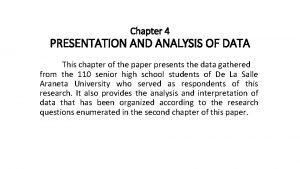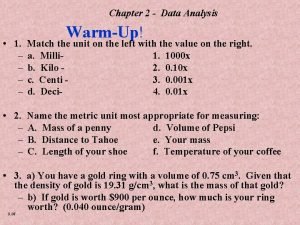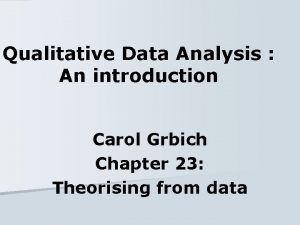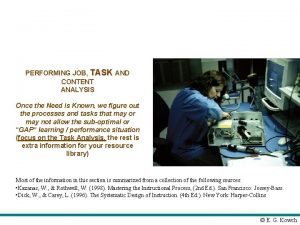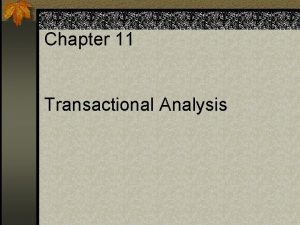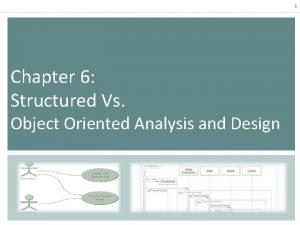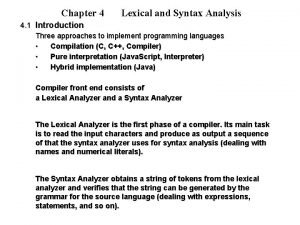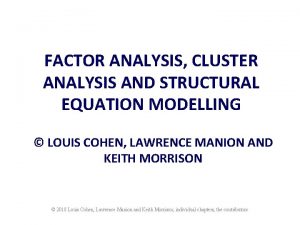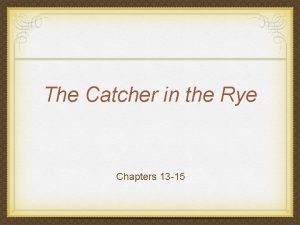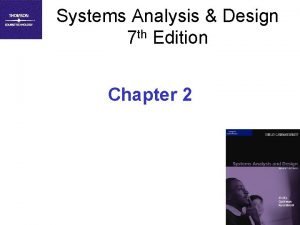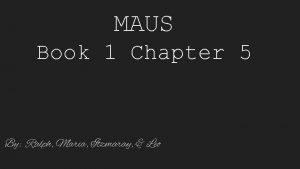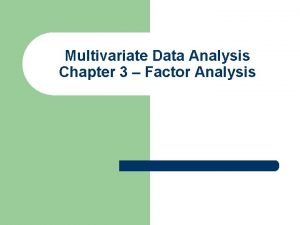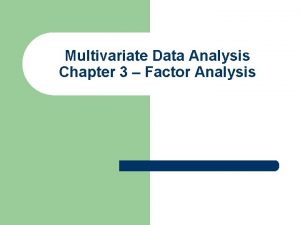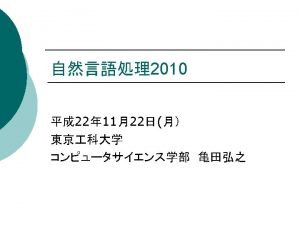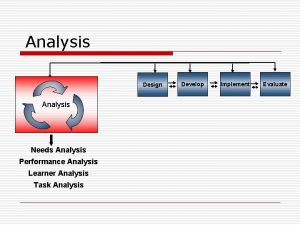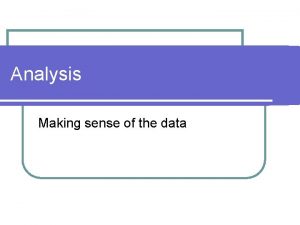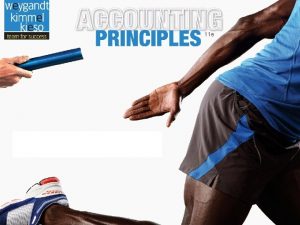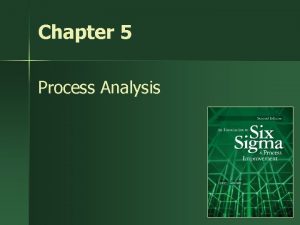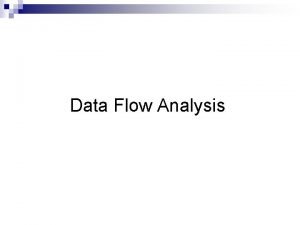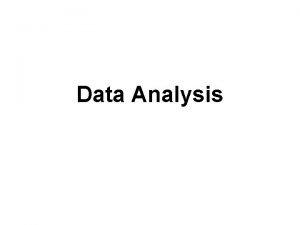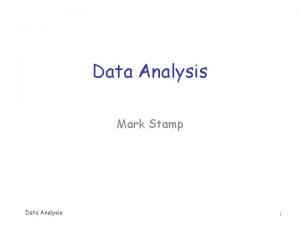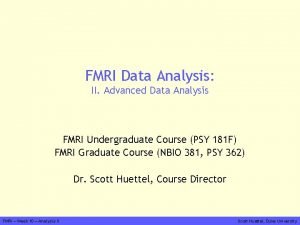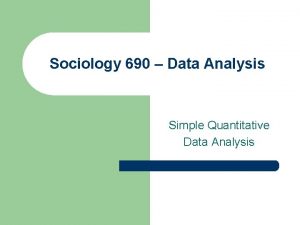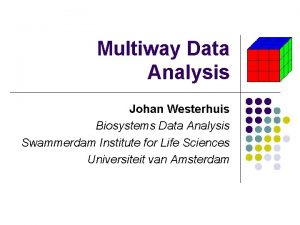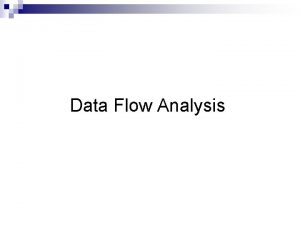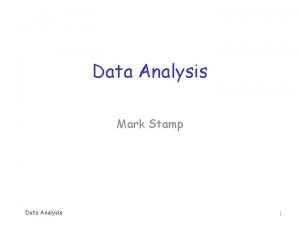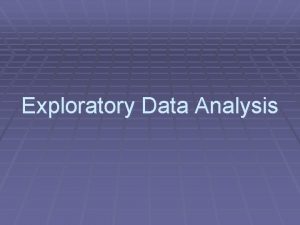Data Analysis CHAPTER 2 2 1 Data analysis





























- Slides: 29

Data Analysis CHAPTER 2

2. 1 Data analysis Measurement s include a number and a unit Scientists need to report data that can be reproduced by other scientists (needed standard units of measurements) Base Units: units of measure that is based on an object or event in the physical world 7 base units in SI

SI Base Units Quantity Base Unit Time Seconds (S) Length Meter (m) Mass Kilogram (kg) Temperature Kelvin (K) Amount of a Substance Mole (mol) Electric Current Ampere (A) Luminous Intensity Candela (cd)

Prefixes Used with SI Units Prefix Symbol Scientific Notation Example Giga G 109 100000 m = 1 Gm Mega M 106 1000000 m = 1 Mg Kilo k 103 1000 m = 1 km Hecto h 102 100 m = 1 hm Deka da 10 10 m = 1 dam Deci d 10 -1 1 m = 10 dm Centi c 10 -2 1 m = 100 cm Milli m 10 -3 1 m = 1000 mm Micro µ 10 -6 1 m = 1000000 µm Nano n 10 -9 1 m = 100000 nm Pico p 10 -12 1 m = 1000000 pm

SI Units

Practice Problems 1) How many centigrams are in a gram? 2) How many liters are in a kiloliter? 3) How many nanoseconds are in a second? 4) How many meters are in a kilometer?

Derived Units SI unit that is defined by a combination of base units Speed (m/s) Volume- space occupied by an object (cm 3, m. L, cc) 1 cm 3 = 1 m. L = 1 cc 1 dm 3 = 1 L Density- a ratio that compares the mass of an object to its volume

Density Mass/Volume g/cm 3 Every sample of a pure substance has the same density Density is used to identify an unknown sample of matter

Practice Problems 1) A 1. 1 g ice cube raises the level of water in a 10 m. L graduated cylinder 1. 2 m. L. What is the density of the ice cube? 2) Suppose you drop a solid gold cube into a 10 m. L graduated cylinder containing 8. 50 m. L of water. The level of the water rises to 10. 70 m. L. You know that gold has a density of 19. 3 g/cm 3. What is the mass of the gold cube?

Temperature Describes how hot or cold the object is relative to other objects Scientists use two different temperature scales Celsius Scale- Water Freezes at 0ºC, Boils at 100ºC Kelvin Scale (SI unit)- Water freezes at 273 K, Boils at 373 K Temperature Conversions C + 273 = K K – 273 = C

Practice Problems: Convert to kelvins. 1) 54 OC 2) -25 OC Convert to degrees Celsius. 32 K 281 K

2. 2 Scientific Notation and Dimensional Analysis Scientific Notation- a way of expressing extremely small and extremely large numbers Numbers greater than 1, exponent is positive (2000 = 2 X 103) Numbers less than 1, exponent is negative (0. 002 = 2 X 10 -3) Decimal point moves left if exponent is positive; moves right if exponent is negative

Practice Problem Express the following in scientific notation. 50 000 0. 000 000 62 0. 000 023 21 300 000

Adding and Subtracting Using Scientific Notation The quantities must have the same exponent If different, must change one so that they are both the same Then add or subtract the numbers

Multiplying and Dividing Using Scientific Notation Exponents do not need to be the same For multiplication: multiply the factors, then add exponents For division: divide the factors, then subtract exponents

Practice Problems Solve the following problems. 5. 10 X 1020 + 4. 11 X 1021 6. 20 X 108 – 3. 0 X 106 (2 X 1014) X (4 X 1012) (12 X 1014) (9 X 1012)

Dimensional Analysis A method of problem solving that focuses on units used to describe matter Often uses conversion factors (a ratio of equivalent values)

Practice Problems 1) How many centigrams are in 5 kilograms? 2) Mount Everest is 8847 m high. How many centimeters high is the mountain? 3) How many hours are there in one week? How many minutes are there in one week?

2. 3 How Reliable are Measurement? Accuracy vs. Precision Accuracy- is how close a measured value is to an accepted value Precision – is how close a series of measurements are to one another

Precise measurements might not be accurate and accurate measurements might not be precise When making measurements, aim for precision and accuracy

Percent Error Experimental values- quantities measured during an experiment Percent error- Ignore all positive/negative signs, only size of error matters

Practice Problems 1) Suppose you calculate your semester grade in chemistry as 90. 1, but you receive a grade of 89. 4. What is your percent error? 2) A length of wood has a labeled length value of 2. 50 m. You measure its length three times. Each time you get the same value: 2. 35 m. A) What is the percent error of you measurements? B) Are your measurements precise? Are they accurate?

Significant Figures Number of digits indicates how precise the measurement is. More digits reported, more precise the measurement Significant Figures include all known digits plus one estimated digit

Rules for Recognizing Figures 1) 2) 3) 4) 5) Significant Non-zero numbers are always significant (45. 23456 has 7 significant figure) Zeros between non-zero numbers are significant (45. 0001 has 6 significant figures) All final zeros to right of decimal are significant (45. 0000 has 6 significant figures) Zeros as placeholders are not significant (0. 0045 and 450 both have 3 significant figures) Counting numbers and defined constants have infinite number of significant figures

Practice Problems: 1) How many significant figures are in the following numbers? 0. 002849 40 030 0. 000 010 2. 4050 X 10 -4 300 100 000

Sig. Figs. In Calculations

Rounding Carry all digits through the entire calculation, then round When performing a calculation, round answer to the fewest sig. figs. in the problem 1. 45 = 1. 5 1. 44=1. 4

Practice Problems: Round each number to five significant figures. 0. 000 249 950 907. 0759 24 501 759 300 100 500 Complete the following calculation. Roun off your answers as needed. 52. 6 g + 309. 1 g + 77. 214 g 927. 37 m. L – 231. 458 m. L 245. 01 km X 2. 1 km 529. 31 m 0. 9000 s

2. 4 Representing Data Line graphs are most common type of graph Other types of graphs are used Bar graphs, pie graphs etc.
 Sources of content analysis
Sources of content analysis Presentation of data what chapter
Presentation of data what chapter Chapter 2 data analysis
Chapter 2 data analysis What are the characteristics of quanlitative research
What are the characteristics of quanlitative research Chapter 10 qualitative data analysis
Chapter 10 qualitative data analysis Data collection procedure and data analysis
Data collection procedure and data analysis Data preparation and basic data analysis
Data preparation and basic data analysis Data acquisition and data analysis
Data acquisition and data analysis What is structured analysis in system analysis and design
What is structured analysis in system analysis and design Cuckoo static analysis
Cuckoo static analysis Discourse vs content analysis
Discourse vs content analysis Differences between error analysis and contrastive analysis
Differences between error analysis and contrastive analysis Types of intralingual errors
Types of intralingual errors Fact-finding techniques in system analysis and design
Fact-finding techniques in system analysis and design Difference between task analysis and content analysis
Difference between task analysis and content analysis Ego state karlsruhe
Ego state karlsruhe Ssad vs ooad
Ssad vs ooad Syntax and lexical analysis
Syntax and lexical analysis Feasibility in system analysis and design
Feasibility in system analysis and design Difference between factor analysis and cluster analysis
Difference between factor analysis and cluster analysis Things fall apart chapter 4-6 summary
Things fall apart chapter 4-6 summary Summarize chapter 8 of the great gatsby
Summarize chapter 8 of the great gatsby Foreshadowing in the great gatsby
Foreshadowing in the great gatsby The great gatsby party chart answers
The great gatsby party chart answers Great gatsby chapter 4
Great gatsby chapter 4 The great gatsby chapter 1
The great gatsby chapter 1 The catcher in the rye chapter 13-15 summary
The catcher in the rye chapter 13-15 summary System analysis and design chapter 2
System analysis and design chapter 2 Chapter 14 financial statement analysis solutions
Chapter 14 financial statement analysis solutions Maus book analysis
Maus book analysis

